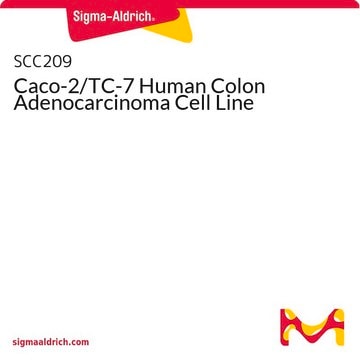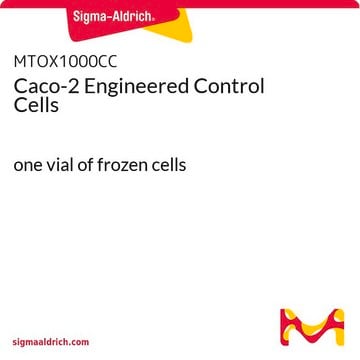09042001
CACO-2
human cervix, Epithelial
Synonym(s):
Caco-II Cells, Caco2 Cells
Sign Into View Organizational & Contract Pricing
All Photos(1)
About This Item
UNSPSC Code:
41106514
Recommended Products
product name
CACO-2, Caucasian colon adenocarcinoma
biological source
human colon
form
liquid
growth mode
(Adherent)
karyotype
(Hypertetraploid, modal no. 96)
morphology
Epithelial
products
Not specified
receptors
Not specified
technique(s)
cell culture | mammalian: suitable
relevant disease(s)
cancer
shipped in
dry ice
storage temp.
−196°C
Cell Line Origin
Human caucasian colon adenocarcinoma, intestinal permeability characteristics tested
Cell Line Description
Isolated from a primary colonic tumour in a 72-year-old Caucasian male using the explant culture technique. Forms moderately well differentiated adenocarcinomas consistent with colonic primary grade II, in nude mice. This CACO-2 catalogue number has undergone testing for intestinal permeability: Dome, microvilli and tight junction formation and transport functionality tested and confirmed present at ECACC.
Application
CACO-2 has been used in the cytotoxicity studies with high pressure-assisted extraction (HPE) fraction of nettle leaf extracts.
CACO-2 may be used as a cell model to study:
CACO-2 may be used as a cell model to study:
- in vitro permeability assay with various biopharmaceuticals
- in iron uptake and absorption studies
- in the cytotoxicity assay with surfactants and transporter inhibitors
- in liposome formulated drug uptake and cytotoxicity studies
Biochem/physiol Actions
Caco-2 (Cancer coli-2) is derived from colorectal adenocarcinoma and grows as an adherent monolayer of epithelial cells. Caco-2 cell line is a widely used intestinal epithelium model and has unique spontaneous differentiation and confluence property. It actively transports vitamins, hormones, amino acids and sugars. Caco-2 expresses various enzymes, ionic and non-ionic transporters similar to normal human epithelia. Caco-2 cell line models grow on filter support. They have simplicity and reproducibility and provide reliable information. Since Caco-2 mimics the intestinal epithelium, it is the preferred cell model for cytotoxic studies, food and drug transport studies.
DNA Profile
STR-PCR Data:
Amelogenin: X
CSF1PO: 11
D13S317: 11,13,14
D16S539: 12,13
D5S818: 12,13
D7S820: 11,12
THO1: 6
TPOX: 9,11
vWA: 16,18
Amelogenin: X
CSF1PO: 11
D13S317: 11,13,14
D16S539: 12,13
D5S818: 12,13
D7S820: 11,12
THO1: 6
TPOX: 9,11
vWA: 16,18
Culture Medium
EMEM (EBSS) + 2mM Glutamine + 1% Non Essential Amino Acids (NEAA) + 10% Foetal Bovine Serum FBS / FCS.
Subculture Routine
Split sub-confluent cultures (70-80%) 1:3 to 1:6 i.e. seeding at 2-4x10,000 cells/cm² using 0.25% trypsin or trypsin/EDTA; 5% CO2; 37°C. NB: During routine subculture the cells should always be subcultured before they achieve confluence. Cells may show the appearance of circular vacuoles in the cytoplasm. These may increase in frequency as the culture density increases to confluence. To reduce their frequency, media change confluent cultures after 2-3 days if not subcultured. Cells can clump if not separated into a single cell suspension when split.
Other Notes
Additional freight & handling charges may be applicable for Asia-Pacific shipments. Please check with your local Customer Service representative for more information.
Cultures from HPA Culture Collections and supplied by Sigma are for research purposes only. Enquiries regarding the commercial use of a cell line are referred to the depositor of the cell line. Some cell lines have additional special release conditions such as the requirement for a material transfer agreement to be completed by the potential recipient prior to the supply of the cell line. Please view the Terms & Conditions of Supply for more information.
NaviCyte Scientific holds the exclusive commercial distribution rights to the CACO-2 cell line deposited by the Memorial Sloan-Kettering Cancer Center. Note: All uses of Catalogue Numbers 86010202 and 09042001, other than for research by a non-commercial or academic entity, require a license and use authorization from NaviCyte Scientific under its exclusive arrangement with Memorial Sloan-Kettering Cancer Center. For information on the licensing terms, please contact NaviCyte Scientific via contact@navicyte-scientific.com or (+1) 973-868-6100.
Disclaimer
RESEARCH USE ONLY. This product is regulated in France when intended to be used for scientific purposes, including for import and export activities (Article L 1211-1 paragraph 2 of the Public Health Code). The purchaser (i.e. enduser) is required to obtain an import authorization from the France Ministry of Research referred in the Article L1245-5-1 II. of Public Health Code. By ordering this product, you are confirming that you have obtained the proper import authorization.
Storage Class Code
10 - Combustible liquids
WGK
WGK 3
Flash Point(F)
188.6 °F - closed cup
Flash Point(C)
87 °C - closed cup
Certificates of Analysis (COA)
Search for Certificates of Analysis (COA) by entering the products Lot/Batch Number. Lot and Batch Numbers can be found on a product’s label following the words ‘Lot’ or ‘Batch’.
Already Own This Product?
Find documentation for the products that you have recently purchased in the Document Library.
Biopharmaceutical classification of desloratadine-not all drugs are classified the easy way
Berginc K, et al.
Acta pharmaceutica (Zagreb, Croatia), 70, 131-144 (2020)
M Lautenschläger et al.
Phytomedicine : international journal of phytotherapy and phytopharmacology, 22(1), 36-44 (2015-02-01)
Extracts of saffron (Crocus sativus L.) have traditionally been used against depressions. Recent preclinical and clinical investigations have rationalized this traditional use. Trans-crocetin, a saffron metabolite originating from the crocin apocarotenoids, has been shown to exert strong NMDA receptor affinity
Comparison study of oral iron preparations using a human intestinal model
Zariwala MG, et al.
Scientia Pharmaceutica, 81, 1123-1140 (2013)
Caco-2 Cell Line
Verhoeckx K, et al.
The Impact of Food Bioactives on Health, 103-111 (2015)
Araceli Valverde et al.
PloS one, 10(6), e0131363-e0131363 (2015-06-25)
Despite the demonstrated benefits of anti-EGFR/VEGF targeted therapies in metastatic colorectal cancer (mCRC), many patients initially respond, but then show evidence of disease progression. New therapeutic strategies are needed to make the action of available drugs more efficient. Our study
Our team of scientists has experience in all areas of research including Life Science, Material Science, Chemical Synthesis, Chromatography, Analytical and many others.
Contact Technical Service







